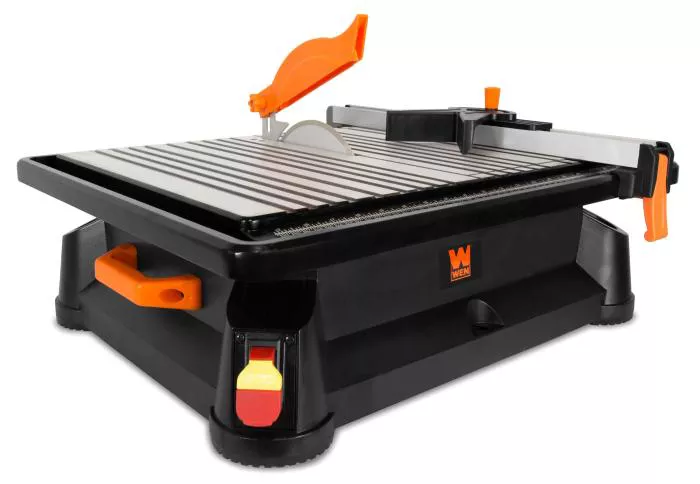A wet tile saw is a specialized power tool designed for cutting ceramic, porcelain, stone, and other hard tile materials. Unlike standard saws, it uses water to cool the blade and reduce dust, ensuring cleaner and more precise cuts. This tool is essential for professional tilers, DIY enthusiasts, and construction workers who need accurate and efficient tile cutting.
The wet tile saw operates by combining a diamond-coated blade with a water reservoir, which continuously lubricates the cutting surface. This process minimizes heat buildup and extends the blade’s lifespan while preventing tile chipping.
How a Wet Tile Saw Works
Water Cooling System
The defining feature of a wet tile saw is its water cooling mechanism. A small pump circulates water from a reservoir onto the blade during operation. This serves two main purposes:
- Reduces Friction – The water prevents overheating, which can damage both the blade and the tile.
- Suppresses Dust – Wet cutting eliminates airborne particles, making it safer for the user.
Diamond-Embedded Blades
Wet tile saws use diamond-coated blades because diamond is one of the hardest materials, capable of cutting through tough surfaces like porcelain and natural stone. The blade rotates at high speeds, while the water keeps it cool and clean.
Cutting Mechanism
The saw can make straight cuts, angled cuts, and even intricate shapes depending on the model. The tile is guided along a sliding tray or table, ensuring precision. Some advanced models feature adjustable cutting angles for beveled edges.
Types of Wet Tile Saws
Tabletop Wet Tile Saws
These are compact, portable saws ideal for small to medium-sized projects. They are commonly used in home renovations and DIY tasks. Tabletop models are lightweight and easy to transport.
Stand-Alone Wet Tile Saws
Larger and more powerful, stand-alone wet tile saws are designed for heavy-duty use. They often include extended cutting tables and more robust motors, making them suitable for professional tilers working on large-scale projects.
Bridge Wet Tile Saws
These saws have a bridge-like structure that holds the blade assembly. They provide excellent stability and precision, making them a preferred choice for intricate tile work.
Key Features to Consider When Choosing a Wet Tile Saw
Motor Power
The motor’s strength determines the saw’s cutting efficiency. For harder materials like granite, a higher horsepower (HP) motor is necessary. Standard models typically range from 1 to 1.5 HP.
Blade Size
Blade diameter affects cutting depth. Common sizes range from 7 to 10 inches. Larger blades allow for deeper cuts, which is useful for thick tiles.
Water Containment System
A well-designed water containment system prevents splashing and ensures continuous blade lubrication. Look for models with effective splash guards and drainage systems.
Portability
If mobility is important, consider lightweight models with foldable stands or wheels. Professionals who work on multiple job sites benefit from portable designs.
Mobility: Handheld routers offer greater mobility, making them suitable for on-site jobs or projects that require flexibility. However, they lack the stability and precision of table routers.
Versatility: While handheld routers are versatile in terms of movement, table routers excel in handling more complex tasks with better control and accuracy.
Price: Handheld routers are generally less expensive, but they often require additional accessories to match the functionality of table routers, which can level the cost.
Performance: For detailed and repetitive tasks, table routers outperform handheld routers by offering better control, precision, and safety.
Advantages of Using a Wet Tile Saw
Precision Cutting
Unlike manual tile cutters, wet tile saws produce smooth, chip-free edges, essential for professional-looking installations.
Versatility
They can cut various materials, including ceramic, porcelain, marble, and glass, making them a versatile tool for different tiling projects.
Dust-Free Operation
The water suppression system eliminates harmful silica dust, improving workplace safety.
Long Blade Life
Water cooling reduces blade wear, allowing for extended use before replacement is needed.
Common Applications of Wet Tile Saws
Flooring Installations
Wet tile saws are widely used in laying floor tiles, ensuring accurate cuts around edges and corners.
Wall Tiling
For backsplashes and shower walls, precise cuts are crucial for a seamless finish.
Custom Tile Designs
Artistic tile patterns, such as mosaics, often require intricate cuts that only a wet tile saw can provide.
Safety Tips When Using a Wet Tile Saw
Wear Protective Gear
Always use safety goggles, gloves, and a dust mask to protect against water splashes and fine particles.
Precision: Table routers offer unparalleled control, allowing you to make exact cuts, grooves, and edges. The stability provided by the table enhances accuracy, making complex projects easier to manage.
Versatility: With various bit options and adjustable settings, table routers can handle a wide range of tasks, from simple trimming to intricate decorative work.
Safety: Table routers generally provide better safety features than handheld routers. The stable platform, along with adjustable fences and featherboards, reduces the risk of mistakes and accidents.
Consistency: When working on repetitive cuts or large projects, a table router ensures consistent results, saving time and reducing material waste.
Secure the Tile Properly
Ensure the tile is firmly placed on the cutting tray to prevent slipping during operation.
Avoid Overloading the Motor
Cutting too quickly or forcing the tile through the blade can strain the motor and reduce efficiency.
Regular Maintenance
Clean the water reservoir and check the blade for wear to maintain optimal performance.
Conclusion
A wet tile saw is an indispensable tool for anyone working with tiles. Its ability to deliver precise, clean cuts while minimizing dust and extending blade life makes it superior to dry cutting methods. Whether for professional use or DIY projects, investing in a quality wet tile saw ensures efficiency, safety, and professional results.
Relate topics:
- The View Of The dewalt circular saw
- How to Fix Crooked Tile Lines: A Comprehensive Guide
- Best Wet/Dry Vacuum Cleaners: Our Top Recommendations for Versatile Cleaning

